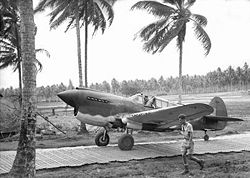- Marsden Matting
-
 Marsden Matting used for airfield construction during WWII at Alexai Point Landing Field, Attu Island, Alaska.
Marsden Matting used for airfield construction during WWII at Alexai Point Landing Field, Attu Island, Alaska.
Marsden Matting is standardized, perforated steel matting material originally developed by the United States at the Waterways Experiment Station shortly before World War II, primarily for the rapid construction of temporary runways and landing strips. The material is also commonly known as Marston mats (or Marston Plate) for a town in North Carolina adjacent to Camp Mackall airfield where the material was first manufactured[1] and used in November 1941.[2] The material was also used in the Korean and Vietnam Wars where its common name, from its Nato Stock Number nomenclature, is pierced (or perforated) steel planking (PSP).
Contents
Description
Marsden matting consisted of steel strips with holes punched through it in rows and a formation of U-shaped channels between the holes. Hooks were formed along one long edge and slots along the other long edge so that they could be connected to each other. The short edges were straight cut with no holes or hooks. To achieve lengthwise interlocking, the mats were laid in a staggered pattern.
The hooks were usually held in the slots by a steel clip that filled the part of the slot that is empty when the adjacent sheets are properly engaged together. The holes were bent up at their edges so that the beveled edge stiffened the area around the hole. In some mats a T-shaped stake could be driven, at intervals, through the holes to keep the assembly in place on the ground. Sometimes the sheets were welded together.
The typical Marsden matting was the M8 landing mat. A single piece weighed about 66 pounds and was 10 ft (3.0 m) long by 15 in (0.38 m) wide. The hole pattern for the sheet was three holes wide by 29 holes long resulting in 87 holes per mat.
A variation made from aluminum was produced to allow easier transportation by aircraft, since it weighed about 2/3 as much. It was referred to as PAP for perforated aluminum planking,[3] but was not as common as aluminum was a controlled strategic material during WWII.
PSP was later, after the war, used by many early South Eastern U.S. racing teams as it was manufactured in the area, and used in many abandoned military airfields. It was also used during a similar period when NASCAR teams used car trailers.
History
World War II
 A Curtiss P-40 Warhawk of No. 76 Squadron RAAF taxiing along Marsden Matting at Milne Bay in September 1942
A Curtiss P-40 Warhawk of No. 76 Squadron RAAF taxiing along Marsden Matting at Milne Bay in September 1942
Marsden Matting was extensively used during World War II by Seabees (Construction Battalions) and other front line construction personnel to build runways and other readily usable surfaces over all kinds of terrain in the Pacific Theater of Operations. A C-47 Skytrain supply aircraft was the first plane to land on the first steel-mat runway constructed in France after the Invasion of Normandy.[4]
On Pacific islands the matting was typically covered with crushed and rolled coral or soil to form a level surface. The perforated and channeled design of the matting created strength and rigidity and facilitated drainage. A runway two hundred feet wide and 5000 feet (1500 m) long could be created within two days by a small team of engineers.
Berlin Airlift
At the start of the Berlin Airlift the runways at Tempelhof Airport in the US Zone in Berlin were made of PSP. Designed to support fighters and smaller cargo aircraft, the Douglas C-54 Skymaster that formed the backbone of the U.S. effort was too heavy for the PSP. Berliners were hired to fix the runway between the three-minute arrivals, running onto the runways with bags of sand to dump onto the mats and soften the surface.
Legacy
Large quantities of matting were produced; approximately 2 million tons costing more than US$200 million (in the 1940s).[5] At the end of the war a large amount of the material remained as war surplus and was pressed into use in various civil engineering applications such as road and bridge construction. As they were made from steel with a high manganese content, the matting was also highly resistant to corrosion.[6] In various countries located in the Pacific Theatre, particularly Papua New Guinea, matting still remains in use as fencing[7] or roadway barriers, in some cases stretching for miles.
See also
- Sommerfeld Tracking - a form of wire matting
References
- ^ Cohen, Stan. The Forgotten War Volume Four. note on page 90.
- ^ Alaska Geographic Vol 22, No 4. p. 12.
- ^ [1]
- ^ Gurney, Gene (Major, USAF) (1962). The War in the Air: a pictorial history of World War II Air Forces in combat. New York: Bonanza Books. p. 175. "U.S. Air Force photo"
- ^ U.S. Army Corps of Engineers article on Landing Mat Development
- ^ Manganese alloy properties
- ^ Tarawa Photos
Categories:- Airfields
- Science and technology during World War II
Wikimedia Foundation. 2010.
